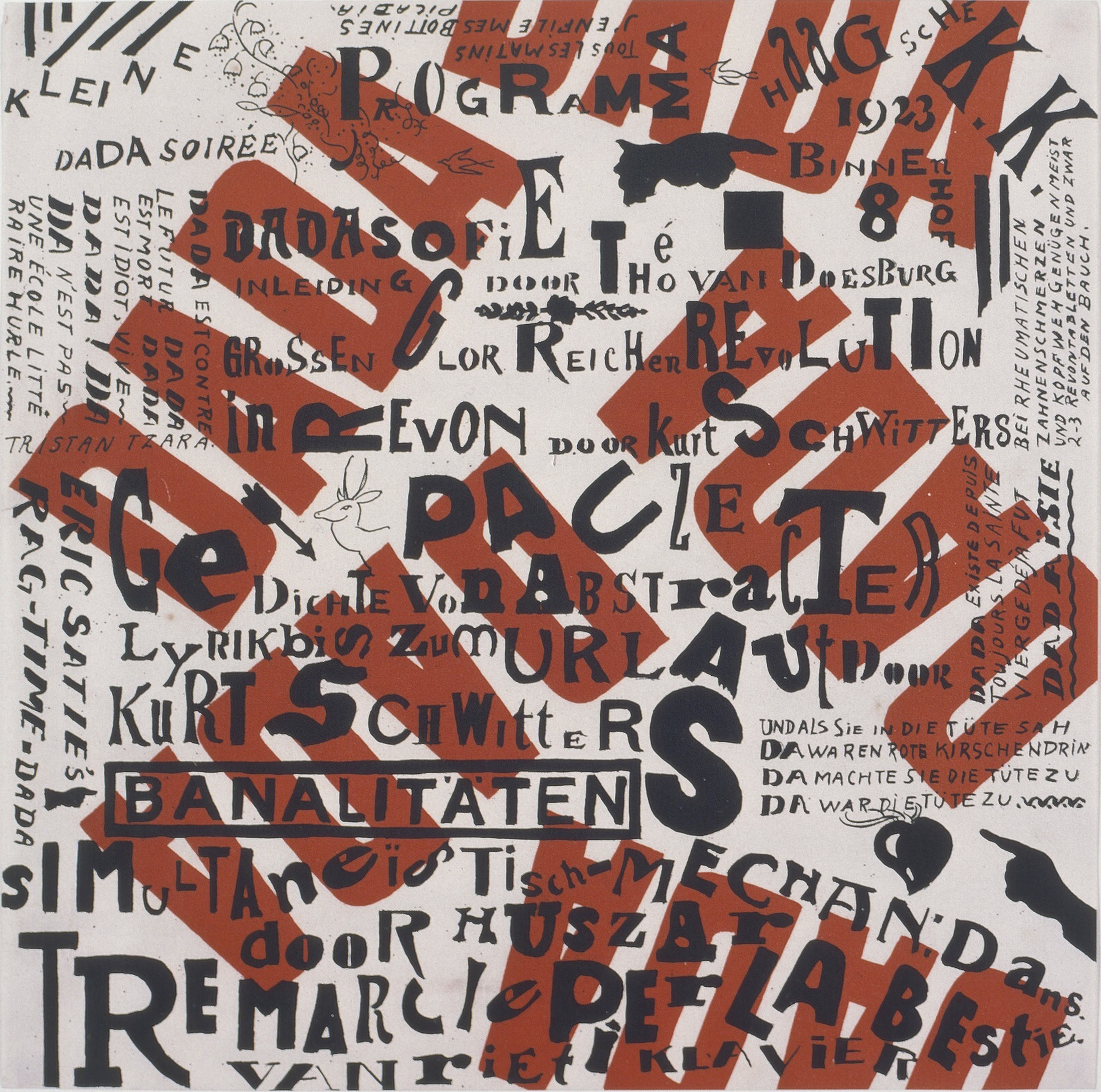




Comparisons
COMPARISONS
Comparisons
COMPARISONS
bold colors
Color reduction is on of the most evident stylistic accordance between Dada Art and contemporary Protest Art. The cause can be found in practical as well as idealistic rational. Both artistic developments share a strong awareness of their viewership, as the transportation of a (political-)message is integrated in the art work. A clear and memorable display of the written statement is a core element of the design. The reduced color palette, that mainly consists of primary colors and black highlights the idealistic concepts behind both movements. Emphasizing the use of daily, non sophisticated materials, it maximizes the effect on the viewer, with minimal expenditure. The conscious decision towards basic materials, production techniques and design is a shared value, a clear link between both artistic styles.
Kurt Schwitters, German, 1887 - 1948
Theo van Doesburg, Dutch, 1883 - 1931
Kleine Dada Soiree (A Little Dada Soiree)
1922
© 2017 Artists Rights Society (ARS), New York / VG Bild-Kunst, Bonn
Fahmi Reza, Malaysian, born 20th century
Grassroots Democracy, from the Occuprint Sponsor Portfolio
2012
© Fahmi Reza
Guerrilla Girls, American, founded 1985
Missing in Action, from the portfolio Guerrilla Girls' Most Wanted: 1985-2006
1991
© Guerilla Girls

Comparison I
Comparison I
type as a design medium
Dada Art is a movement that comprises a variety of artistic genres, such as literature, poetry, music and visual art. One of the basic concepts is the junction of these different genres. This is particularly evident in Hugo Ball´s poem KARAWANE. Its written form is set in a variety of typefaces, using a fantasy language, while its performance is a liaison between reading, acting, performance and music. This blending of artistic design and text becomes one of the core elements of Dada Art and strongly influenced contemporary protest art. Type is not separated from the artwork but its main element of expression, transformed to express ideas beyond its written content as a visual tool.
Karawane
Hugo Ball, German, 1886–1927
1917; published 1920
Elle, from the journal "291"
Marius de Zayas, Mexican, 1880–1961
No. 9, November 1915
When in Riot Gear, from the Occuprint Sponsor Portfolio
John Emerson, American, born 1973
2012
© John Emerson

Comparison II
Comparison II
Occupying public space in media:
Following a clear motive, to spread Dada as a movement around the world, the wide distribution of the Dadaistic ideas was very important. The publication of posters, articles, and newspapers was one of the main focuses of Dadaist artists. A large part of the remaining visual oeuvre is therefore in the form of printed magazines and posters. The occupation of public space through newspapers and posters are another strong analogy to contemporary protest art. Even in todays age of social media the written and printed word, especially in the newspaper seems to carry a strong attraction to protest artists. This is evident in the newspaper design of the Guerrilla Girls, as well as Emily Jacir´s work that uses adds in the newspaper to occupy public space.
Marius de Zayas, Mexican, 1880 - 1961
Title page, from the journal "291" (No. 1, March 1915) (portfolio), 1915
Guerrilla Girls, American, founded 1985
Publisher: Guerrilla Girls
Token Times, from the portfolio Guerrilla Girls' Most Wanted: 1985-2006, 1995
© Guerrilla Girls
Emily Jacir, Palestinian, born 1970
Sexy Semite, 2002
© Emily Jacir

Comparison III
Comparison III
Paper as a print medium
Printed posters, artworks and signs are the main medium used in contemporary Protest Art, in spite of the rise of social media and online newsfeeds. Even when used online, such as the Guerilla Girls poster, paper as a medium is still an essential design element. The haptic texture of paper as well as its conceptual qualities make it the preferred material choice of Dadaists and contemporary Protest Artists. Dadaists, such as Marcel Duchamp, used paper as a medium, as it is an article of daily use, unglamorous and non pretentious. A commodity of abundance paper is not elitist and allows easy reproduction and duplication, features that attracted the Occupy movement, that based a large importance of there protests on the paper posters. Marcel Duchamp highlights the quality of paper as a material in his work by using different variations for handwritten notes, creating the illusion of momentarily and chance.
Marcel Duchamp, French, 1887 - 1968
The Bride Stripped Bare by Her Bachelors, Even (The Green Box)
September 1934
© Association Marcel Duchamp / ADAGP, Paris / Artists Rights Society (ARS), New York 2017
Guerrilla Girls, American, founded 1985
Publisher: Guerrilla Girls
10 Trashy Ideas about the Environment, from the portfolio Guerrilla Girls' Most Wanted: 1985-2006
1995
© Guerrilla Girls
Nobodycorp. Internationale Unlimited, Indonesian, 21st century
#Occupy Jakarta: Serakah Itu Salah!, from the Occuprint Sponsor Portfolio
2012
© Nobodycorp











